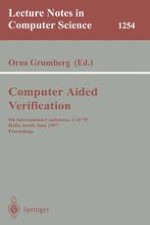This book constitutes the strictly refereed proceedings of the 9th International Conference on Computer Aided Verification, CAV '97, held in Haifa, Israel, in June 1997.
The volume presents 34 revised full papers selected from a total of 84 submissions. Also included are 7 invited contributions as well as 12 tool descriptions. The volume is dedicated to the theory and practice of computer aided formal methods for software and hardware verification, with an emphasis on verification tools and algorithms and the techniques needed for their implementation. The book is a unique record documenting the recent progress in the area.
